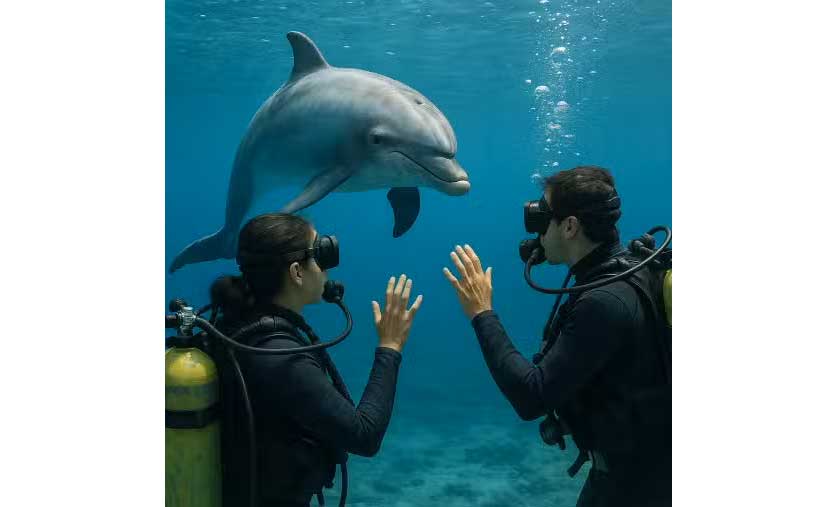AI Meets Dolphins: Google’s DolphinGemma Decode Cetacean Vocal Patterns, Revealing a Real Language with Shared Meanings
It took half a century of underwater recordings, hundreds of hours of observations, and, finally, artificial intelligence, but we finally have proof: dolphins don’t just communicate, they speak a real language.
News hit the headlines around the world when a team of researchers from the Woods Hole Oceanographic Institution won the prestigious Coller Dolittle Award for demonstrating that the non-signature whistles of Sarasota dolphins. They are used by all members of the group with shared meanings, just like words in human languages.
Dolphins Have Language: The Discovery That Changes Everything
For decades, scientists have studied dolphin “signature whistles,” the distinctive sounds that each dolphin develops as a juvenile and maintains throughout its life, essentially functioning as a name. But they only account for about half of dolphin vocalizations. The other half, so-called “nonsignature whistles,” have remained largely unexplored.
The team led by the biologist Laela Sayigh of the Woods Hole Oceanographic Institution, together with Vincent Janik of the University of St. Andrews, Frank Jensen of Aarhus University, and Randall Wells of the Sarasota Dolphin Research Program, has shown that these non-signature whistles have a much more sophisticated function than previously imagined. They are a real language, the language of dolphins.
The research, awarded with 100.000 dollars by the Jeremy Coller Foundation, identified distinct types of non-signature whistles used by multiple dolphins to communicate. Using sound reproduction experiments conducted under completely natural conditions in the open ocean, the team found that a particular type of non-signature whistle elicits an avoidance response, suggesting an alarm function.
Sarasota Dolphin Whistle Database represents a unique resource in the world for the study of dolphin communication. It contains 926 recording sessions of 293 individual dolphins, of which the age, sex and maternal lineage are known in the majority of cases.
This archive has allowed researchers to confirm the hypothesis, formulated in the 1960s by David and Melba Caldwell, that each dolphin has a unique whistle that functions as a sound signature. But now we know that there is much more: dolphins do not only “call each other by name,” but they use a real shared language.
Technology at the Service of Interspecies Communication
It’s not just the Sarasota Dolphin Research Program that’s moving: Google He developed DolphinGemma, an artificial intelligence model designed to analyze and decipher the natural sounds made by dolphins. This system, based on advanced audio technologies and equipped with approximately 400 million parameters, can identify recurring sound patterns and even predict which sounds will follow in a sequence, similar to how AI models work for human speech.
The model was trained on the Wild Dolphin Project’s acoustic database, which includes decades of recordings of Atlantic spotted dolphins. The goal? The same as always: reveal hidden structures and possible meanings in dolphins’ natural communication.
Dolphin Language: Not Just Name and Surname
What emerges is a revolutionary vision of dolphin communication. It is not just mutual recognition or coordination during hunting, but a real linguistic system with shared elements. A second non-signature whistle identified by researchers seems to have an interrogative function, produced in response to unexpected or unfamiliar situations.
A multimodal communication
I was telling you about it in this article: Dolphins do not limit themselves to acoustic communication. Recent studies have shown that these marine mammals also possess a surprising sensitivity to electrical fields, an ability that further enriches their sensory and communicative arsenal.
This electrical sensitivity, mediated by so-called ‘vibrissal crypts’ (small openings on the dolphins’ snouts), could integrate with the acoustic communication system, creating an incredibly sophisticated multimodal language that we are only now beginning to decipher.
The Implications of Recognizing a Dolphin Language
Recognizing that dolphins use actual language has profound ethical implications. If these marine mammals can communicate complex ideas to each other, we may need to fundamentally reconsider our relationship with them and the responsibilities that come with it.
Projects like CAT (Cetacean Hearing Augmentation Telemetry), developed in collaboration with the Georgia Institute of Technology, are already exploring the possibility of two-way interactions with dolphins. This underwater computer is designed to create a shared vocabulary based on artificial whistles associated with objects familiar to dolphins.
In concrete terms, as reported by Trieste All News, the instrument generates synthetic whistles referring to common elements in the dolphins’ habitat, such as algae or sea grasses, with the aim of “training” the animals to imitate these whistles to refer to the elements in question.









